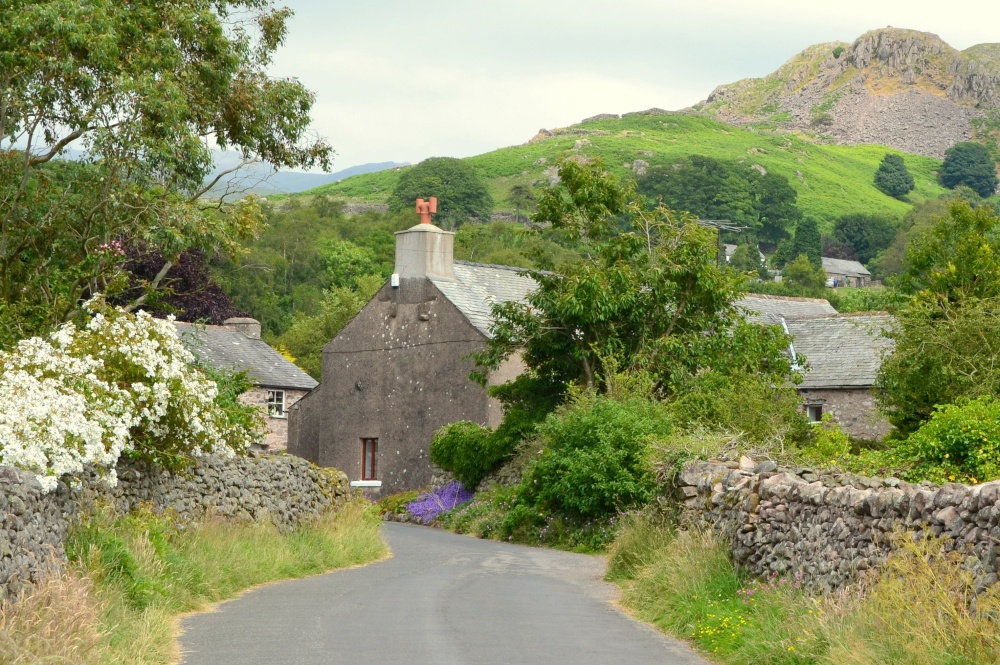
Eskdale ramble - Image by PicturesOfEngland.com member Martin Humphreys (view gallery)
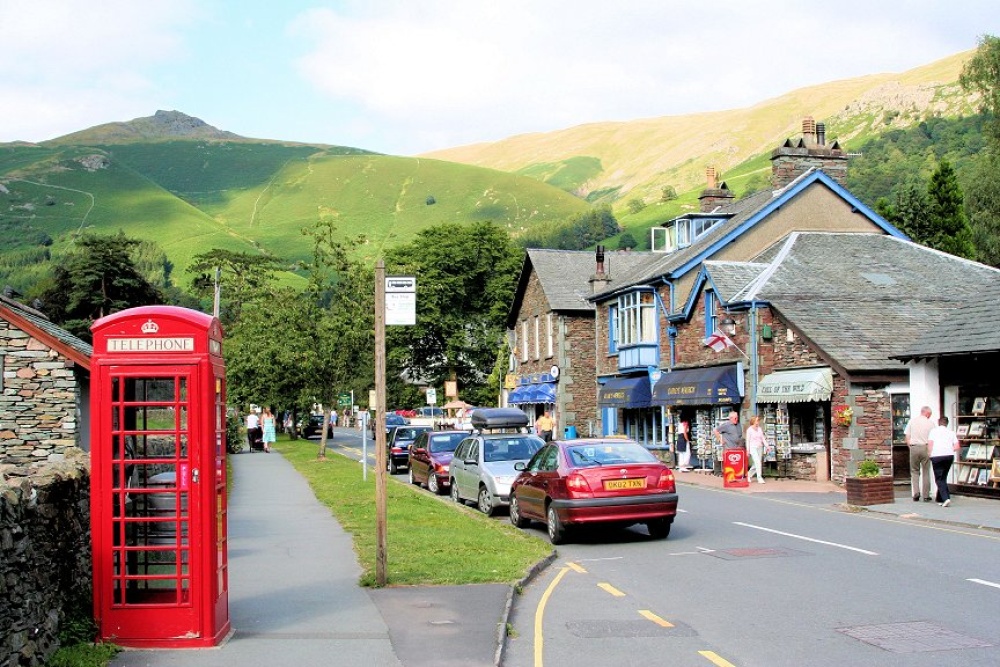
Grasmere, Cumbria - Image by PicturesOfEngland.com member Brett Hughes (view gallery)
This tiny stone village is beautifully set between the tranquil waters of Grasmere Lake and the jagged heights of Helm Crag and Nab Scar. Close-by is a beautiful natural arena where the famous Grasmere Sports are staged each August, this event perpetuates many Lakeland traditions. Local sheepdog trials are held in the village at around the same time.
The village and its valley are seen at their best from the surrounding hills To the left of the village is the Swan Hotel and it is reputed that Sir Walter Scott had breakfast here whilst staying with the celebrated poet Wordsworth. Born in 1770, William Wordsworth died at his home Rydal Mount in the year 1850 a few days after his 80th birthday. His years here were happy and productive, he must have drawn much inspiration from the beauty and tranquility of this spectacular Lakeland area.
William and his devoted sister Dorothy, lived in a delightful stone cottage situated beyond the village church where a lane skirts the fields before reaching Town End and a pretty cluster of stone slate roofed cottages with glorious westward views. They moved together into Dove Cottage, originally an inn called the Dove and Olive Bough for which they paid an annual rent of £8.00. In the year 1782 the poet married Mary Hutchinson, and three of their children were born at Dove Cottage during the following four years.
In 1808, the Wordsworth’s moved to Allan Bank and the cottage became the home of their friend Thomas de Quincey, author of The Confessions of an English Opium Eater.
The Wordsworth Museum, a short distance from Dove Cottage, contains many of Wordsworth's personal possessions and there is also a reconstruction of a typical farmhouse kitchen.
Allan Bank, where the Wordsworth’s lived until 1811 is not open to visitors. The poet and his family spent the next two years at the Rectory opposite the Church of St. Oswald before moving to Rydal Mount which is situate on the road between Grasmere and Ambleside where the great man was to spend the rest of his life.
There are many pleasant building in and around Grasmere and just past the Swan Hotel, at a point close to the River Rothay an old creeper covered house stands by the bridge. It is perhaps one of the most attractive houses in the village. Grey-green and purple tinged stone shops, houses and cottages flank Broad Street which has a pleasant little green at it's junction with College Street. Several hotels are clustered in the heart of Grasmere, before the main road reaches the Church on the bank of the Rothay. The small building by the lych gate was the village school from 1660 until 1854.
William Wordsworth knew the village church of St. Oswald well, he described it in his epic poem, The Excursion, thus it is immortalised forever. In the church near the alter, an inscribed profile in white marble depicts Wordsworth between graceful daffodils and bluebells.
Every year on a Sunday nearest to 5th August, St. Oswalds day, a colourful, rush bearing procession wends its way through Grasmere to the church. The ancient ceremony, kept alive in Grasmere and a few other villages in the North of England dates from the time when church floor were bare earth and had rushes spread over them for warmth and cleanliness. Grasmere's church was paved with flagstones in the 19th-century but this symbolic ceremony continues today.
As you wander through this delightful village, beauty abounds all around in the form of towering peaks, magnificent lakes and glistening waterfalls, coupled with enchanting buildings and the romance of a famous English poet, you will surely ask ' who could wish for anything more' for this whole area is majesty and peace beyond compare.
ID#49

Eskdale ramble - Image by PicturesOfEngland.com member Martin Humphreys (view gallery)
Boot is one of Lakeland's precious jewels, a charming stone village surrounded by towering scenery which includes two of the regions most scenic waterfalls, the Dalegarth Force and Birker Force.
The region is known for its long association with milling which began in these parts as far back as the 12th century. A pack-horse bridge of the 17th century leads to Eskdale Mill of 1578. Much of this mill remains in working order, it is unusual in that it is a two-wheeled watermill which at one time provided water for the whole valley. The mill contains an exhibition of milling, allowing visitors to see how the ancient wooden machinery worked.
A favourite visit in the region is the church dedicated to St.Catherine. Standing in a lovely location beside the River Esk this 12th century church is a traditional barn-style chapel of the type often found in the wilderness parts of Lakeland. Interesting features are the stained glass windows and the old font decorated with marigold designs.
Scafell Pike, England's highest mountain looms over the village, beyond in a northerly direction lies the wilderness Burn Moor, an unpopulated area where relics of the Stone-Age including 3,000 year old circles have been identified. Even more remote, lying at 2,490 ft is Esk Hause where amidst the fells a tiny spring bursts forth giving life to the River Esk which meanders its way through idyllic misty scenery down through Eskdale to flow through Boot.
Another building with a strong appeal to fell walkers is the village inn, the 300 year old Woolpack. This offers traditional Lakeland hospitality, choice ales and tasty food. In fine weather, tourists take advantage of the pretty garden area where there are picnic tables.
A short distance from the village there is an Outward Bound School for Mountaineering, this offers courses for enthusiasts and overnight accommodation for walkers and climbers. The house was built in 1896, it is a typical Lakeland country house with an enchanting garden from which there are fine views in all directions.
The Eskdale Show, staged in September at Brotherilkeld Farm, is famous all over the county for its fell racing, hound trailing, sheep displays, and its hound and terrier show. For any visitor to the area the show makes a great day out, there is a host of other country activities and stalls with country clothing, hand carved walking sticks and all manner of things to do with country pursuits.
ID#8909
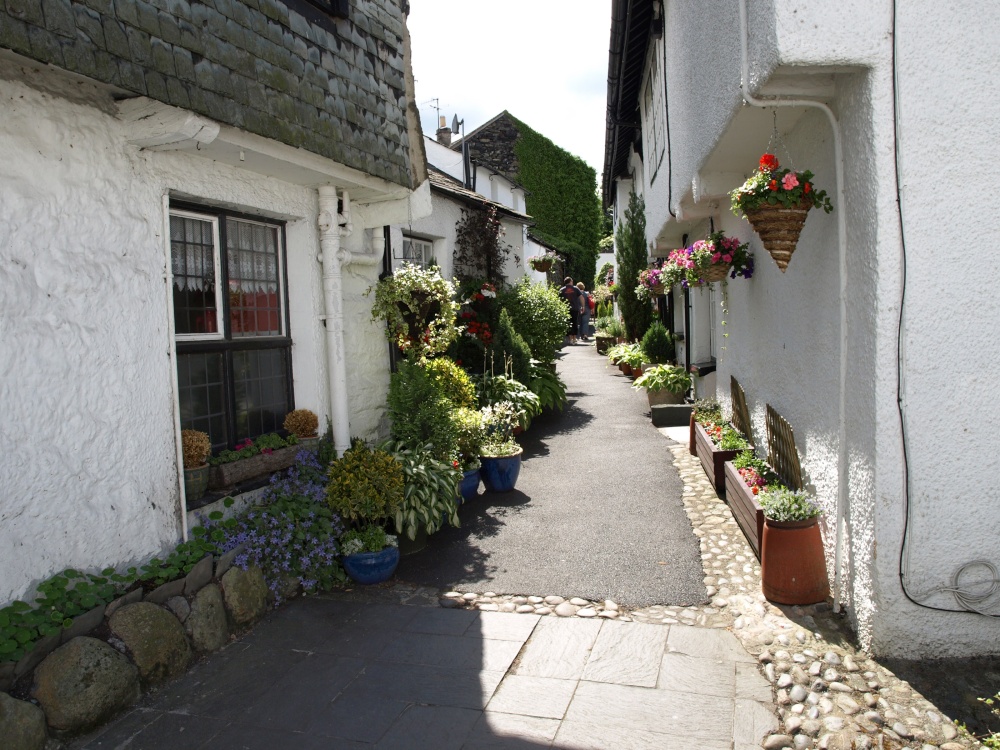
Hawkshead village - Image by PicturesOfEngland.com member Dave John (view gallery)
The pretty village of Hawkshead is full of old-world picturesque charm throughout its traffic-free streets where one can roam freely to investigate all it has to offer in the way of shops, cafes, quaint tea rooms, and ancient inns that serve delicious locally-sourced traditional food.
There is plenty of history too, with plenty to see and do. The Old Grammar school in Hawkshead, dates back to 1585 and is where the famous poet William Wordsworth went to school along with his brother Richard. The old desks inside the school still contain carvings done by William and his brother. The school is now a museum open to the public, and is a must visit, as too is the Beatrix Potter Gallery where you can often see some of Beatrix Potter's original artwork. The gallery is housed in a 17th-century house that was once the law office of her husband.
ID#50
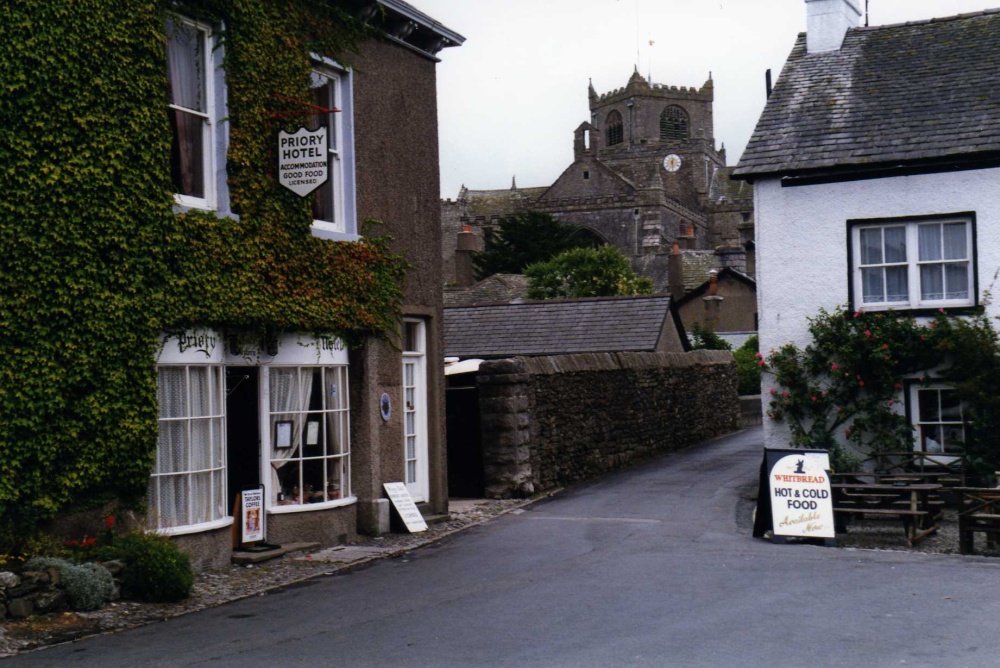
In the village - Cartmel, Cumbria - Image by PicturesOfEngland.com member Alan Dixon (view gallery)
Cartmel's village square is surrounded by old shops, pubs and a 14th century gatehouse owned by the National Trust. It is famous for its 12th century priory of cathedral like proportions, reached via a narrow street crammed with cottages leading to a bridge across the River Dee to where Cartmel Priory stands.
The priory is one of the few English monastic churches to survive Henry VIII's Reformation, it escaped almost entirely unscathed, leaving its soaring belfry to be seen as a landmark from almost all parts of the town. The church has a magnificent stained glass window of the 15th century and contains superb choir stalls. Today, this lovely peaceful church still provides a place of worship for the villagers and hordes of tourists who flock here throughout the year.
The village has a friendly atmosphere, it has changed little throughout the centuries and has pleasant, slower pace. Amenities include a post office, general grocery store and the usual gift and souvenir shops where you can purchase the local "Sticky Toffee Pudding". There are several pubs in the village, all serve good food, ales and wine, and for a real treat why not visit Cartmel's two restaurants - both featured in the "Good Food" guide.
With all the glories of Lakeland on the doorstep and the lovely coastal resort of Grange-over-Sands with its fine views of Morecambe Bay, Cartmel makes an ideal base for touring the patchwork of lakes, fells and tarns, or for enjoying the miles of breathtaking Cumbrian coast. Visitors to the area will be impressed with the mild climate caused by the Gulf Stream washing over Morecambe Bay. This allows for slightly higher temperatures, making the region a year round destination for holiday makers. Visitor attractions include Holker Hall and Cartmel Racecourse.
ID#9510
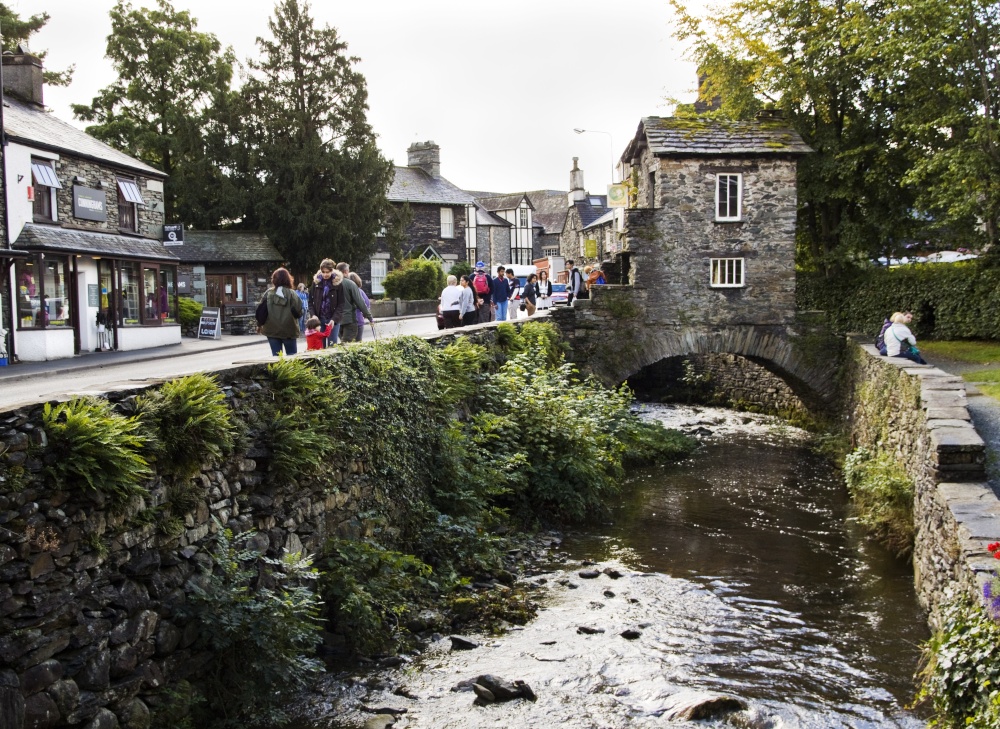
Bridge House Ambleside - Image by PicturesOfEngland.com member Dave John (view gallery)
Ambleside, meaning "Shieling" or summer pasture by the riverbank, lies next to the northern shore of the beautiful Lake Windermere. It is a small but busy Victorian town that is an extremely popular spot with tourists, as it is an ideal location to base yourself from when exploring the Lake District. The town centre has a host of interesting craft shops, cafe's, guest houses and hotels, and on a wednesday you will find an open-air Market. One of the buildings in Ambleside is said to be the most photographed building in the whole of the Lake District - the Bridge House. This building was originally used as an apple store and was ingeniously built directly over Stock Beck on a stone arch in order to avoid paying any land tax! It is now however a National Trust Shop after being aquired by them in 1926. Although a small building it is said that it was once home to a family of eight! It is also a place that artists love to paint. The great English landscape artist J.M.W Turner (1775 - 1851) painted it. Also, a few miles North of the town at Grasmere you will find Rydal Mount and Dove Cottage, two of the homes of the famous English poet William Wordsworth.
ID#17
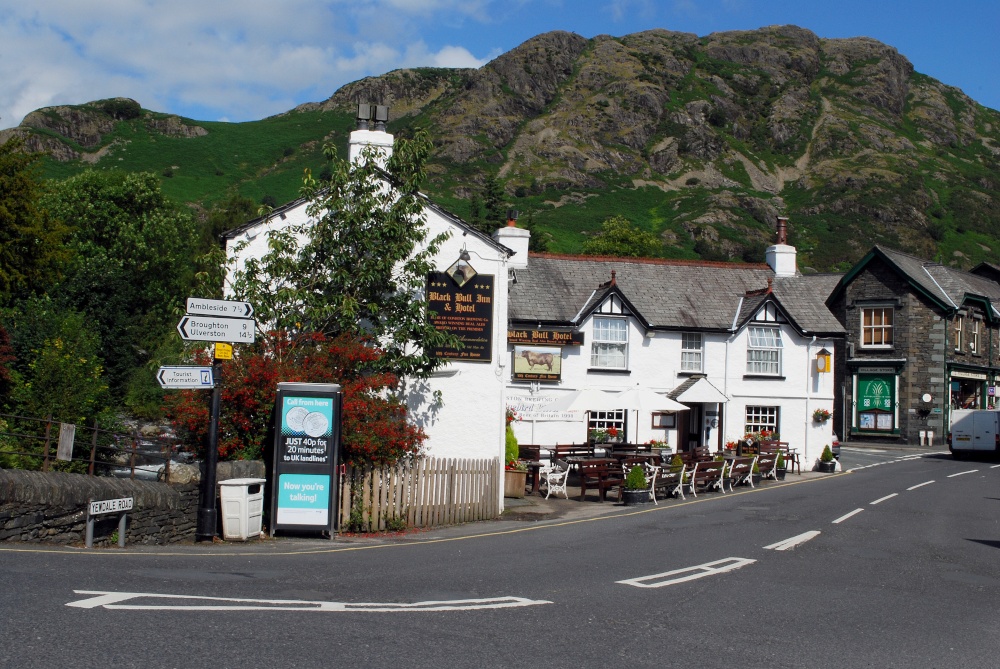
Black Bull Inn - Image by PicturesOfEngland.com member Ray Hutcheon (view gallery)
There is a timelessness about this pretty village which is set beneath the awesome splendour of "The Old Man of Coniston" towering some 2,500ft above.
The properties in the village, though not of great age are attractive and charming. Some are built from the dark local stone and others have walls that glisten with whitewash. Of the architectual features to be found in Coniston, perhaps the most handsome is a whitewashed, seven doorway terrace, right beneath the Old Man and overlooking the Church Beck's boulder-strewn waters. This terrace is said to be about 165 years old.
Apart from the infinite beauty of Coniston Water, it will be long remembered as the place where Donald Campbell died while trying to break the world water-speed record in 1967. His jet-powered Blue-Bird lost control at more than 300 m.p.h. and it is only recently that Donald Campbell's body was recovered.
Of the historic features - nearby the main street a museum pays tribute to the life and celebrated work of John Ruskin, the victorian writer, critic and social reformer. Ruskin had a profound influence on the general artistic taste of his time and he lived at his home on the far side of Coniston Water from 1871 until his death in 1900. Given the great honour of a grave in Westminster Abbey, he chose instead to buried in a quiet corner of the local churchyard and lies beneath a beautifully carved wooden cross.
Interestingly, this beautiful place was chosen by Arthur Ransome as the setting for his world famous novel Swallows and Amazons.
Coniston and the surrounding lakeland area is popular with anglers, fell walkers and climbers. People converge here for a variety of reasons at all times of the year. In the summer when the sun shines and the land is fresh and green, the beautiful scenery of the lakes is best enjoyed from the water. In the autumn and winter months, with snow clinging to the peak of The Old Man and water cascading down ridges in a series of endless waterfalls, it is then, that this picturesque place comes into its own. The dark waters of Coniston, spread out on the valley floor beneath the snow covered mountainous Old Man in a setting of unrivalled beauty is indeed Lakeland's "Jewel in the Crown" it is no wonder that this special place has long remained the haunt of many celebrated Artists.
Other lakes in the area are, Windermere, Wast Water and to the north of this great area lies Bassenthwaite Lake, Ullswater and Derwent Water. There are many enchanting towns and villages and a host of genial inns and pubs. There are a great many shops all well stocked with the requirements of modern living to locally made souvenirs.
ID#242
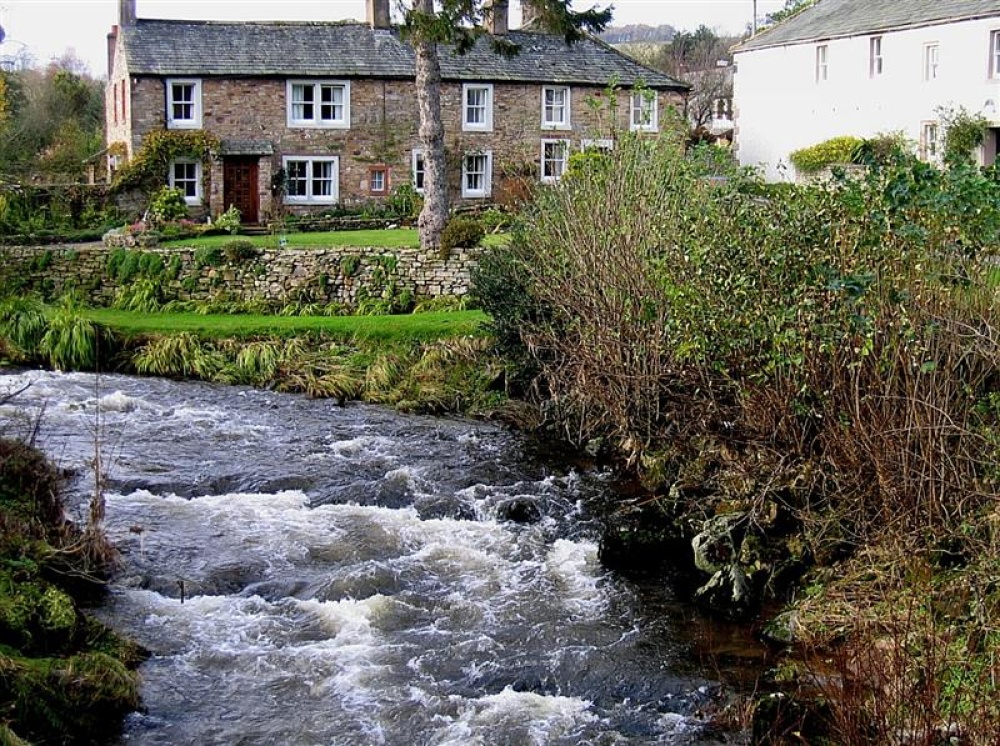
The pretty village of Caldbeck in Cumbria. Taken Nov 05 using Canon Powershot S50 - Image by PicturesOfEngland.com member Sheila Bell (view gallery)
An old brewery stands beside the Caldbeck - a tribute to the cold clear waters which gave the village its name. Caldbeck, which means 'cold stream' in Old Norse, grew up where two hill streams meet in a valley below the Cumbrian fells.
Caldbeck, was the home of John Peel, a local man who was born here in 1776. Peel, met and married a local girl, Mary White and they produced thirteen children.
More than any other past-time, Peel loved Hunting and he often followed the hounds in traditional Lakeland style, on foot. He is immortalised by the song D'ye ken John Peel. The words to this famous song were written by his friend, John Woodcock Graves. John worked in a mill making the grey cloth mentioned in one of the verses and, the song was set to music by William Metcalfe, the Carlisle Cathedral Organist.
Commemorating Peel's death in 1854 is an elaborate headstone carved with hunting horns. This stands close to the door of Caldbecks Church. A sandstone shelter close to the churchyard gate is dedicated to Peel and Graves but there is no mention of William Metcalfe.
Caldbeck is a captivating village, there are fine views towards a series of Lakeland peaks. The local Church of St. Kentigern dates from the 12th-century but was latterly restored in 1932. There is a gracious 18th-century Rectory with Gothic windows and in the centre of the village there are some well preserved 18th-century cottages. This pretty area is known as Midtown. A picturesque footbridge spans the Caldbeck and leads to Friar Row, a group of cottages with Cumberland slate roofs. These stone cottages were built around 1800.
Caldbeck is surrounded by the Majestic scenery of Lakeland, tarry a while and in a flight of fancy, you will swear that you can see John Peel in his gay hunting jacket, striding across the fells on his way to join up with his beloved hunt.
Nearby, the old town of Penrith and the City of Carlisle provide the visitor with endless shopping facilities, museums and Art galleries. Many inns and restaurants an be found near Caldbeck and in the beautiful surrounding countryside.
John Peel.
D'ye ken John Peel with his coat so gay,
D'ye ken John Peel at the break of the day,
D'ye ken John Peel when he's far, far away,
With his hounds and his horn in the morning?
Chorus.
For the sound of his horn brought me from my bed,
And the cry of his hounds which he oft-times led;
Peel's view halloo would awaken the dead,
Or the fox from his lair in the morning.
Yes, I ken John Peel and Ruby too!
Ranter and Ringwood, Bellman and True,
From a find to a check, from a check to a view,
From a view to a death in the morning.
Then here's to John Peel from my heart and soul,
Let's drink to his health, let's finish the bowl,
We'll follow John Peel thro' fair and thro' foul,
If we want a good hunt in the morning.
D'ye ken John Peel with his coat so gay?
He lived at Troutbeck once on a day;
Now he has gone far, far, far away;
We shall ne'er hear his voice in the morning.
Written by John Woodstock Graves for his friend, the Cumbrian huntsman, John Peel (1776 - 1854).
To quote from John Peel: The Man and the Song, John Woodcock Graves said the following in his account written in 1863:
Nearly forty years have now wasted away since John Peel and I sat in a snug parlour at Caldbeck, hunting over again many a good run, when a flaxen-haired daughter of mine came in saying "Father, what do they say to what Granny sings?" Granny was singing to sleep my eldest son with a very old rant called "Bonnie (or Cannie) Annie." The pen and ink for hunting appointments being on the table the idea of writing a song to this old air forced itself on me, and thus was produced, impromptu "D'ye ken John Peel with his coat so gray." Immediately after I sang it to poor Peel, and I well remember saying to him in a joking style, "By Jove, Peel, you'll he sung when we're both run to earth."
John Peel died from a horse fall in 1854 with 3000 people attending his funeral.
ID#248
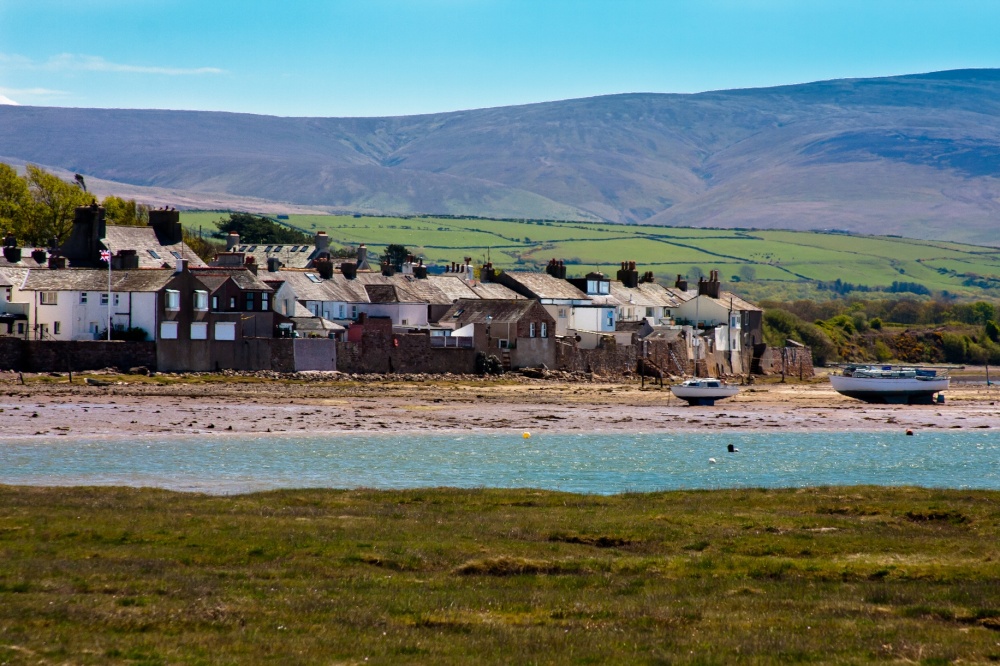
Saltcoats near Ravenglass - Image by PicturesOfEngland.com member Klaas Roelofsen (view gallery)
Special for being the only coastal village within the Lake District National Park, Ravenglass lies where three important rivers converge into the sea. It is this favoured position that made the town so important to the Romans who, centuries ago built a fort here at the spot they called Glannaventa. The remains of the fort bath-house rank amongst the best preserved Roman buildings in the north.
Dramatic Lakeland scenery surrounds Ravenglass which appears as if wedged between mountains and sea at a point where the estuary curves inland, protecting the village from fierce off-shore winds. For generations villagers here garnered a living from the fruits of the sea and strong sea-faring traditions still exist amongst the tight-knit community.
Ravenglass is also the terminus of the Ravenglass and Eskdale Light Railway. Built in 1875 to carry iron ore from the Eskdale Valley to mainline Furness further along the coast. The line is restored and bright steam engines pull refurbished coaches loaded with passengers on a wonderful journey through the beautiful Eskdale Valley. Interestingly, the line was the first narrow-gauge railway in England and is known locally as Old Ratty. Ravenglass Railway Museum recalls the history of the line, the village people and the area.
Today, Ravensglass is a resort appreciated by all the family; there is excellent boating, fishing, picturesque estuary walks and the village is within a short distance from delightful Muncaster Castle dating from around 1200. The castle has a fine display of elegantly furnished rooms containing, antiques, tapestries and paintings. In the beautifully laid out ornamental grounds there is a fascinating owl centre. At nearby Drigg Dunes you will find a nature reserve which is the home of the largest colony of Black Headed Gulls in Europe.
Places to visit include: Roman Bath House, Muncaster Mill, Muncaster House and Owl Sanctuary, Ravenglass and Eskdale Railway, Drigg Dunes Nature Reserve, Wast Water Lake and Swinside Stone Circle.
ID#9007
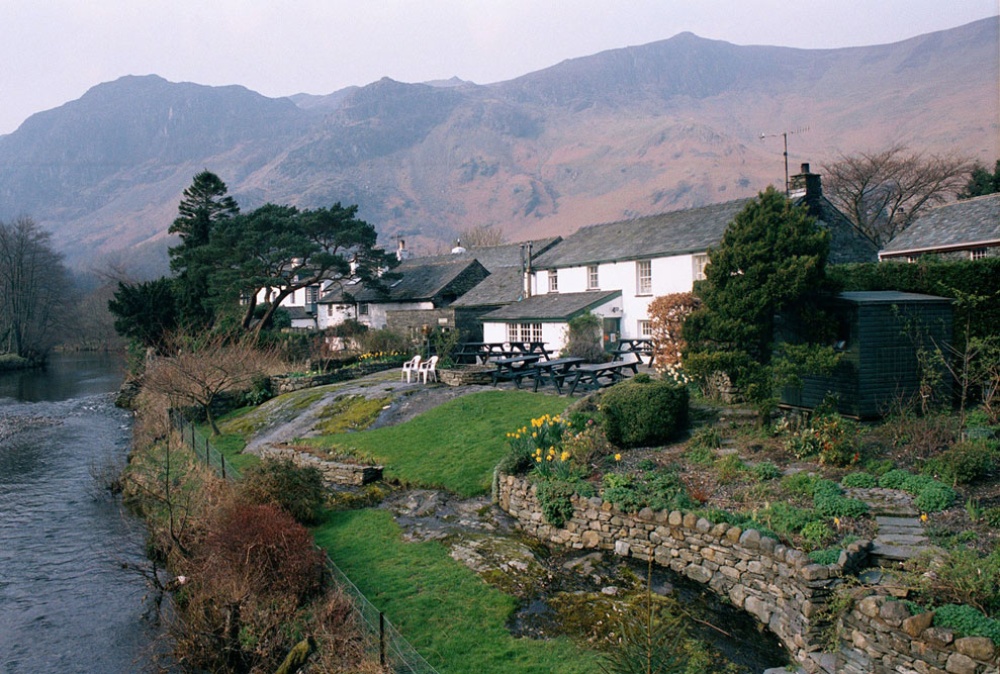
Tea room at Grange in Borrowdale, Cumbria - Image by PicturesOfEngland.com member Seph Turner (view gallery)
There is a point where Borrowdale opens out to meet the shore of Derwent Water and it is here that the village of Grange lies in a landscape of towering splendour. Grange itself rises only 250ft above sea level but the scree-covered slopes, covered in turf and bracken soar majestically immediately behind the village and little more than a mile away peaks rise in grandeur to a height of over 2,000ft.
From here the River Derwent flows into Derwent Water and the Waters, with the sun shining down, giving them a copper-like glint,
present a magnificent picture.
Borrowdale is part of the unique volcanic landscape of the Lake District. The volcanic rock provides some of the world's finest roofing slates; those from the Borrowdale-Butterworth group of quarries are brilliant green in colour.
Mining has been important in these fells since roman times. Queen Elizabeth 1st is said to have imported workers here from Germany. By the mid 1560's furnaces were working in Keswick, smelting iron ore. The famous Graphite mine, higher up in Borrowdale at Seathwaite, is known in more recent times for the lead pencil industry based in Keswick but during the 18th-century this mine was used for casting Cannon Balls.
The clear, pebble bedded River Derwent is spanned by a graceful but narrow bridge and it is this that links Grange to the Keswick Road.
All around this area are wonderful vistas with old whitewashed cottages dotted here and there. Many of these cottages have remained unchanged for years and present a picture of quiet tranquility - in the winter months these cottages are aglow with twinking lights and smoke pouring from the chimney. Some, still have a Donkey or two roaming in the garden reminding one of the times when these small, scattered villages, could only be reached on foot or by horseback and these gentle animals carried goods brought in from neighbouring towns and villages.
The fells around here provide fine walking country. The air is fresh and bracing and there are wonderful views all around. It is a peaceful place and as such, Grange is a joy to visit at any time of year.
ID#246
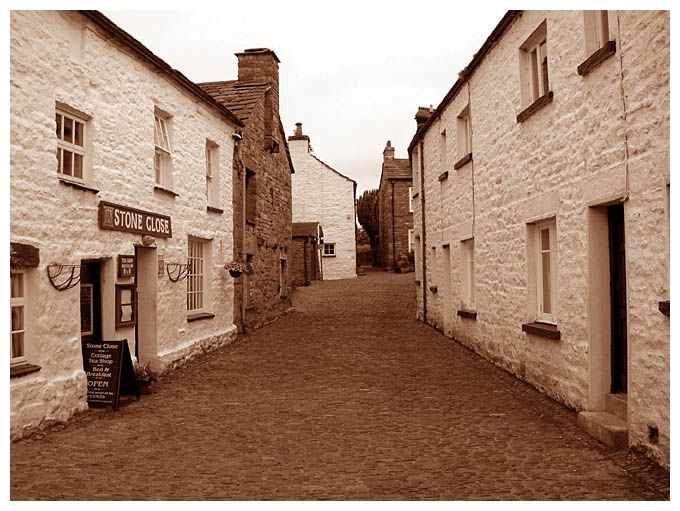
Dent - Image by PicturesOfEngland.com member Tony Quinlan (view gallery)
Chance upon the village of Dent and you chance upon some of the finest countryside in the Cumbrian Dales. Dent lies above the River Dee and is overlooked by towering hills and fells.
Here you will find no pavements to amble along, cobbled streets are a dominant feature of Dent, so too are the old stone cottages grafted together beneath thick slabbed roofs as if in a show of strength against the gales that in winter frequently lash these upland regions The local inn is a pretty black and white timbered building and although many of the cottages and houses are of natural stone, some have been enhanced with colour-wash and have brightly painted window frames and doorways. The centre of the village is adorned by a fountain commemorating Adam Sedgwick. He was a famous son of Dent B.1785-D.1873) he was professor of geology at Cambridge University and went on to become one of the greatest geologists of his time. He was the son of the local Parson and never forgot his roots. There is a memorial to him in the parish church.
A path behind the fountain leads to St.Andrew's Church. Historically, the church was built in 1417 but is said to stand on 11th-century foundations. The church is cool and beautiful and contains several memorials to the Sedgwick family. In the churchyards stands the Old Grammer School where Adam Sedgwick was first taught by his father along with other pupils from the village.
Dent was noted for it's cottage industry of 'knitting' during the 18th-century and, often the income gleaned from this was the only
money to support some families. Dent is an atmospheric place, you tramp the cobbles and it is a though pictures of 18th-century
knitters, huddled in doorways, flash before your eyes. Step beyond the streets, and the views in every direction are simply magical, it is surrounded by Calf Top, Craghill and a little more distant is Whernside which rises to over 2,000ft and is the highest point in the Dales National Park.
The towns of Kirkby Lonsdale and Kendal are equi-distance from Dent, both mirror the enchantment of the Dales and offer much to the visitor. At Sedbergh you will find the Dales Visitors Centre.
ID#9243
| Article Title | Author | Date |
| Stonehenge | David Coe | 23rd January 2024 |
| Derwent Dam: A Historic Icon in the Heart of Derbyshire | David Coe | 14th January 2024 |
| The Native Trees of England: A Botanical Tapestry | David Coe | 15th December 2023 |
| Stoke-on-Trent: The Potteries Hub | David Coe | 12th December 2023 |
| England's 'Heritage at Risk Register' 2023 | David Coe | 11th December 2023 |
| Where to see Daffodil Displays in the South West of England | poe | 3rd March 2023 |
| 10 Famous Landmarks in Dorset | poe | 1st March 2023 |
| List of popular Dorset market towns including market day | poe | 1st March 2023 |
| 10 Best Historic Attractions to visit in York, England | poe | 16th May 2022 |
| 9 Market Towns To Visit In The Cotswold | poe | 21st March 2022 |